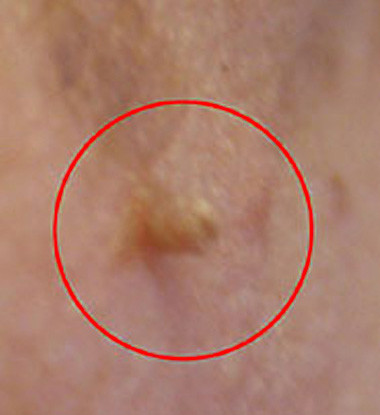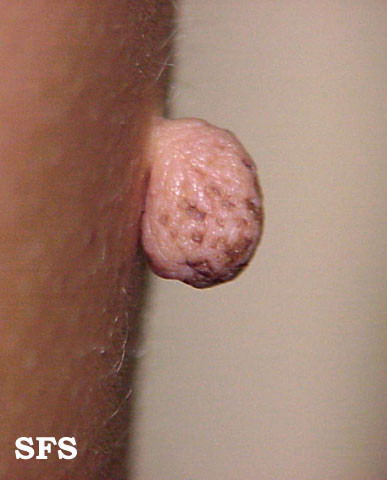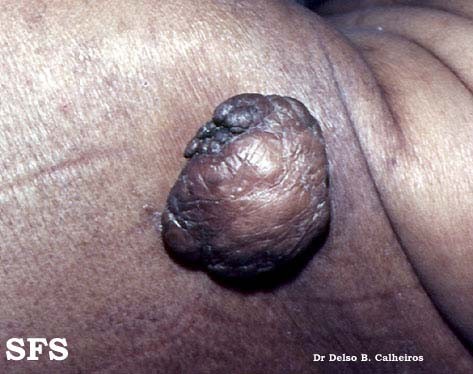Skin Tags Causes, Location, Pictures, Cancer Risk, Treatment
There are many different types of protruding skin growths apart from a wart of mole. Skin tags are another common growth. While most of these skin growths are not associated with any serious conditions like skin cancer, it should always be investigated further. Skin tags are harmless and painless growths often seen on the upper body like on the eyelid, neck or armpits.
What are skin tags?
Skin tags are also small and soft protrusions from the skin surface. It is also known as cutaneous papillomas or acrochordon. These are common benign growths that can occur anywhere but are more likely to develop on the folds of the skin like in the armpits. It usually does not grow beyond a certain size and is not associated with any significant medical complications. Most of the time it is removed for cosmetic reasons although larger tags may need to be removed due to chaffing and pain.
Globally the incidence of skin tags is around 46%. It affects both males and males equally. The condition is common later in life and studies have shown that it affects 1 out of 2 people by the age of 70 years. Skin tags are not harmful and therefore do not need to be treated. There have been some theories about the link between skin tags and colon polyps as well as skin tags and high blood cholesterol level. Studies have shown that there are no such links and when it does occur simultaneously it is purely coincidental.
Location of Skin Tags
Skin tags are small and the exact shape and structure is difficult to see with the naked eye. Very large skin tags may be due to the accumulation of fat tissue within the growth. A skin tag is smooth or rough, skin colored or slightly darker. It tends to arise more frequently on the face, neck, trunk and folds of the body (intertriginous areas – where two skin surfaces make contact) like the armpits (axillae), under the breast and groin area.
This has given rise to the belief that a skin tag may be an overgrowth from excessive rubbing of the two skin surfaces (chaffing) but this has not been conclusively established. Growths on the genitals, like the labia (women) and penis (men) should always be examined for the possibility of sexually transmitted infections like HPV (human papillomavirus). Read more on STD symptoms in men and STD symptoms in women.
Causes of Skin Tags
The exact cause of skin tags is unclear. It was at one time thought to be due to a loss of elastin in the skin but this does not seem to be the underlying cause. Studies have shown that skin tags are linked to several conditions such as diabetes, HPV (human papilloma virus) that causes warts, acromegaly (excess growth hormone) and in pregnancy. It is more common in people who are overweight or obese and in people who abuse steroids.
Another reason why skin tags may occur is due to chaffing. The irritation is a result of the skin rubbing together which is more common in the folds of the body and with obesity. It is also believed to be associated with age-related changes in the skin as the condition is more often seen in older men and women. Although it is suspected that it may be related to a viral infection apart from HPV, the exact association with an infection is unclear.
What do skin tags look like?
Skin tags look like small tags on the skin, hence the name. It is a protrusion that hangs out from the surface of the skin and is either skin colored or darker in color (hyperpigmented).Skin tags are made up of collagen fibers and blood vessels surrounded by skin. The epidermis on the skin tag may be thickened or abnormally thin.
Skin tags are usually around 2 to 5mm in diameter but can grow as large as 5cm. Some skin tags may have a stalk (pedunculated). These tags can become twisted which may cut off the blood supply to it and then it may fall off. Smaller skin tags tend to occur on the upper body while larger tags are usually found on the lower part of the body.
Most skin tags are small and there are often multiple tags in the same area. Larger tags typically occur individually. The areas where it is more likely to occur include the eyelids, armpits, neck, under the breasts, upper chest and groin.
Pictures of Skin Tags
The pictures below have been sourced from Dermatology Atlas Brazil (atlasdermatologico.com.br)
Risk of Cancer
Skin tags are benign meaning that they are non-cancerous. However, skin lesions should always be investigated by a dermatologist in order to identify malignant (cancerous) lesions as early as possible. It s not uncommon for pre-cancerous or cancerous lesions to be mistaken for harmless skin growths. There are cases where basal cell carcinoma and squamous cell carcinoma in situ were initially mistaken for skin tags. Therefore self-diagnosis is not advisable. Overall skin tags are harmless, painless and do not change over time unless with most skin cancers.
Acrochordon Treatment
Most skin tags present with no other symptoms. However, in some cases larger tags may be a problem and therefore needs to be removed. Constant rubbing or scratching can cause trauma to the skin and this may then need medical treatment. There are different methods by which these skin tags can be removed and the method of choice depends on various factors. Skin tag should not be removed at home without medical attention. It can lead to complications such as an infection, bleeding and scarring of the skin.
Excision
Excision simply means that the skin tag is cut out with a scalpel of scissors. There is bleeding afterwards so topical applications like aluminum chloride may be applied to the skin before it is surgically removed. Excision can be used for both small and large skin tags. There is usually some scarring with an excision but it is mainly isolated to the area where the tag was located.
Cryotherapy
Cryotherapy or freezing is where a very cold fluid or gas like liquid nitrogen is applied to a skin lesion. The substance is usually sprayed on or applied with an applicator for just a few seconds. It causes rapid freezing of living tissue once it comes into contact with the skin. However, if not applied properly the surrounding normal skin can be adversely affected.
Electrosurgery
Electrosurgery or diathermy is where an electric current is applied to the skin. It heats the area and destroys the abnormal growth. Furthermore it can seal the blood vessels in the area thereby preventing any bleeding. This type of burning is done under controlled circumstances and should only be done by a medical professional.
Ligation
With this procedure a suture is tied tightly around the base or neck of the skin tags. This cuts off the blood supply to the skin tag, gradually leading to death of the tissue which then allows it to fall off. Never try to perform a ligation on a skin tag at home with thread, dental floss or fishing line. These type of makeshift home procedures can lead to complications.
References
- Skin tags. Dermnet NZ
- Acrochordon. Medscape
Last updated on August 18, 2018.




